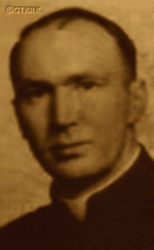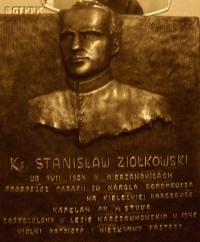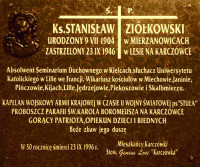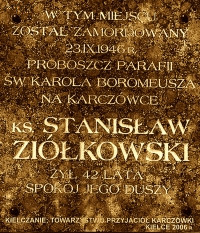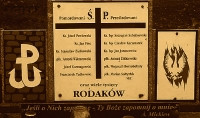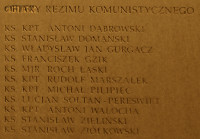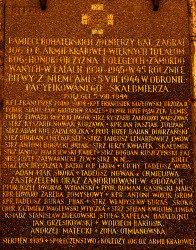Roman Catholic
St Sigismund parish
05-507 Słomczyn
85 Wiślana Str.
Konstancin deanery
Warsaw archdiocese, Poland
full list:
displayClick to display full list

searchClick to search full list by categories
wyświetlKliknij by wyświetlić pełną listę po polsku

szukajKliknij by przeszukać listę wg kategorii po polsku

Martyrology of the clergy — Poland
XX century (1914 – 1989)
personal data
surname
ZIÓŁKOWSKI
forename(s)
Stanislav (pl. Stanisław)
function
diocesan priest
creed
Latin (Roman Catholic) Church RCmore on
en.wikipedia.org
[access: 2014.09.21]
diocese / province
Kielce diocesemore on
www.diecezja.kielce.pl
[access: 2012.12.28]
Polish Catholic Mission in France
RC Military Ordinariate of Polandmore on
en.wikipedia.org
[access: 2014.12.20]
date and place
of death
23.09.1946

Kielcetoday: Kielce city pov., Holy Cross voiv., Poland
more on
en.wikipedia.org
[access: 2021.06.07]
details of death
In 08.1939 ordered to leave France „for a too militant patriotism […] and attempts to persuade people not to accept French citizenship”.
Released from pastoral ministry went to Poland for holidays.
After German invasion of Poland on 01.09.1939 (Russians invaded Poland 17 days later) and start of the World War II joined one of the accidentally encountered Polish army unit and served as its chaplain.
After start of the German occupation arrested by the Germans for the first time on 11.12.1940 — due to the fact that the inhabitants of his parish did not provide a required quota of forced deliveries — but released.
Ministered in Skalbmierz and Masłów and collaborated there with the clandestine resistance Polish Home Army AK (part of Polish Clandestine State) as its chaplain under nom‐de‐guerre „Stole”.
Arrested again by the Germans in 07.1943 but managed to escape from the gaol.
Till 01.1945 in hiding, ministering as AK chaplain though.
After German defeat and start of another Russian occupation murdered by a Commie policeman when on the way to school, in a forest by the church.
The policeman was subsequently amnestied by the Commie‐Nazi Russian regime in Poland, by Boleslav Bierut, Russian agent and traitor.
cause of death
murder
perpetrators
Russians / Poles
sites and events
GeneralgouvernementClick to display the description, Ribbentrop‐MolotovClick to display the description, Pius XI's encyclicalsClick to display the description
date and place
of birth
09.07.1904

Mierzanowicetoday: Wojciechowice gm., Opatów pov., Holy Cross voiv., Poland
more on
en.wikipedia.org
[access: 2022.01.28]
alt. dates and places
of birth
09.06.1904
presbyter (holy orders)
ordination
10.06.1933

positions held
1945 – 1946
parish priest — Kielcetoday: Kielce city pov., Holy Cross voiv., Poland
more on
en.wikipedia.org
[access: 2021.06.07] ⋄ St Charles Borromeo RC parish ⋄ Kielcetoday: Kielce city pov., Holy Cross voiv., Poland
more on
en.wikipedia.org
[access: 2021.06.07] RC deanery
1943 – 1945
vicar — Masłówtoday: Masłów Pierwszy, Masłów gm., Kielce pov., Holy Cross voiv., Poland
more on
en.wikipedia.org
[access: 2022.04.12] ⋄ Transfiguration of the Lord RC parish ⋄ Kielcetoday: Kielce city pov., Holy Cross voiv., Poland
more on
en.wikipedia.org
[access: 2021.06.07] RC deanery
1941 – 1943
vicar — Skalbmierztoday: Skalbmierz gm., Kazimierza Wielka pov., Holy Cross voiv., Poland
more on
en.wikipedia.org
[access: 2021.06.07] ⋄ St John the Baptist RC parish ⋄ Skalbmierztoday: Skalbmierz gm., Kazimierza Wielka pov., Holy Cross voiv., Poland
more on
en.wikipedia.org
[access: 2021.06.07] RC deanery
1940 – 1941
vicar — Piekoszówtoday: Piekoszów gm., Kielce pov., Holy Cross voiv., Poland
more on
en.wikipedia.org
[access: 2021.06.07] ⋄ Nativity of the Blessed Virgin Mary RC parish ⋄ Piekoszówtoday: Piekoszów gm., Kielce pov., Holy Cross voiv., Poland
more on
en.wikipedia.org
[access: 2021.06.07] RC deanery
1940
vicar — Jędrzejówform.: Andrzejów
today: Jędrzejów gm., Jędrzejów pov., Holy Cross voiv., Poland
more on
en.wikipedia.org
[access: 2021.06.07] ⋄ Bl. Vincent Kadłubek RC parish ⋄ Jędrzejówform.: Andrzejów
today: Jędrzejów gm., Jędrzejów pov., Holy Cross voiv., Poland
more on
en.wikipedia.org
[access: 2021.06.07] RC deanery
1939
student — Lilletoday: Lille arr., Nord dep., Hauts‐de‐France reg., France
more on
en.wikipedia.org
[access: 2022.07.18] ⋄ Université catholique de Lille (Eng. Catholic University in Lille), known as „La catho” — studies planned
1938 – 1939
priest — Wazierstoday: Douai arr., Nord dep., Hauts‐de‐France reg., France
more on
en.wikipedia.org
[access: 2022.07.21] ⋄ Notre–Dame–des–Mineurs RC church — among Polish emigrants and migrants
1937 – 1938
priest — Nœux‐les‐Minestoday: Pas‐de‐Calais dep., Hauts‐de‐France reg., France
more on
en.wikipedia.org
[access: 2021.12.18] — among Polish emigrants and migrants
1936 – 1937
vicar — Kijetoday: Kije gm., Pińczów pov., Holy Cross voiv., Poland
more on
en.wikipedia.org
[access: 2021.06.07] ⋄ St Peter and St Paul the Apostles RC parish ⋄ Pińczówtoday: Pińczów gm., Pińczów pov., Holy Cross voiv., Poland
more on
en.wikipedia.org
[access: 2021.06.07] RC deanery
1936
vicar — Ogrodzieniectoday: Ogrodzieniec gm., Zawiercie pov., Silesia voiv., Poland
more on
en.wikipedia.org
[access: 2022.04.12] ⋄ Transfiguration of the Lord RC parish ⋄ Pilicatoday: Pilica gm., Zawiercie pov., Silesia voiv., Poland
more on
en.wikipedia.org
[access: 2020.12.11] RC deanery
1936
vicar — Daleszycetoday: Daleszyce gm., Kielce pov., Holy Cross voiv., Poland
more on
en.wikipedia.org
[access: 2021.06.07] ⋄ St Michael the Archangel RC parish ⋄ Daleszycetoday: Daleszyce gm., Kielce pov., Holy Cross voiv., Poland
more on
en.wikipedia.org
[access: 2021.06.07] RC deanery
1936
vicar — Pińczówtoday: Pińczów gm., Pińczów pov., Holy Cross voiv., Poland
more on
en.wikipedia.org
[access: 2021.06.07] ⋄ St John the Evangelist RC parish ⋄ Pińczówtoday: Pińczów gm., Pińczów pov., Holy Cross voiv., Poland
more on
en.wikipedia.org
[access: 2021.06.07] RC deanery
1934 – 1936
vicar — Janinatoday: Busko‐Zdrój gm., Busko‐Zdrój pov., Holy Cross voiv., Poland
more on
en.wikipedia.org
[access: 2021.06.07] ⋄ St Adalbert the Bishop and Martyr RC parish ⋄ Stopnicatoday: Stopnica gm., Busko‐Zdrój pov., Holy Cross voiv., Poland
more on
en.wikipedia.org
[access: 2021.12.18] RC deanery
1933 – 1934
vicar — Pilicatoday: Pilica gm., Zawiercie pov., Silesia voiv., Poland
more on
en.wikipedia.org
[access: 2020.12.11] ⋄ St John the Baptist and St John the Evangelist RC parish ⋄ Pilicatoday: Pilica gm., Zawiercie pov., Silesia voiv., Poland
more on
en.wikipedia.org
[access: 2020.12.11] RC deanery
1933
vicar — Kozłów Miechowskitoday: Kozłów, Kozłów gm., Miechów pov., Lesser Poland voiv., Poland
more on
en.wikipedia.org
[access: 2021.12.19] ⋄ Exaltation of the Holy Cross and Our Lady of Perpetual Help RC parish ⋄ Sędziszówtoday: Sędziszów gm., Jędrzejów pov., Holy Cross voiv., Poland
more on
en.wikipedia.org
[access: 2020.11.27] RC deanery
1927 – 1933
student — Kielcetoday: Kielce city pov., Holy Cross voiv., Poland
more on
en.wikipedia.org
[access: 2021.06.07] ⋄ philosophy and theology, Theological Seminary
sites and events
descriptions
Generalgouvernement: After the Polish defeat in the 09.1939 campaign, which was the result of the Ribbentrop‐Molotov Pact and constituted the first stage of World War II, and the beginning of German occupation in part of Poland (in the other, eastern part of Poland, the Russian occupation began), the Germans divided the occupied Polish territory into five main regions. In two of them new German provinces were created, two other were incorporated into other provinces. However, the fifth part was treated separately, and in a political sense it was supposed to recreate the German idea from 1915 (during World War I, after the defeat of the Russians in the Battle of Gorlice in 05.1915) of creating a Polish enclave within Germany. Illegal in the sense of international law, i.e. Hague Convention, and public law, managed by the Germans according to separate laws — especially established for the Polish Germ. Untermenschen (Eng. subhumans) — till the Russian offensive in 1945 it constituted part of the Germ. Großdeutschland (Eng. Greater Germany). Till 31.07.1940 formally called Germ. Generalgouvernement für die besetzten polnischen Gebiete (Eng. General Government for the occupied Polish lands) — later simply Germ. Generalgouvernement (Eng. General Governorate), as in the years 1915‐1918. From 07.1941, i.e. after the German attack on 22.06.1941 against the erstwhile ally, the Russians, it also included the Galicia district, i.e. the Polish pre‐war south‐eastern voivodeships. A special criminal law was enacted and applied to Poles and Jews, allowing for the arbitrary administration of the death penalty regardless of the age of the „perpetrator”, and sanctioning the use of collective responsibility. After the end of the military conflict of the World War UU, the government of the Germ. Generalgouvernement was recognized as a criminal organization, and its leader, governor Hans Frank, guilty of war crimes and crimes against humanity and executed. (more on: en.wikipedia.orgClick to attempt to display webpage
[access: 2024.12.13])
Ribbentrop‐Molotov: Genocidal Russian‐German alliance pact between Russian leader Joseph Stalin and German leader Adolf Hitler signed on 23.08.1939 in Moscow by respective foreign ministers, Mr. Vyacheslav Molotov for Russia and Joachim von Ribbentrop for Germany. The pact sanctioned and was the direct cause of joint Russian and German invasion of Poland and the outbreak of the World War II in 09.1939. In a political sense, the pact was an attempt to restore the status quo ante before 1914, with one exception, namely the „commercial” exchange of the so‐called „Kingdom of Poland”, which in 1914 was part of the Russian Empire, fore Eastern Galicia (today's western Ukraine), in 1914 belonging to the Austro‐Hungarian Empire. Galicia, including Lviv, was to be taken over by the Russians, the „Kingdom of Poland” — under the name of the General Governorate — Germany. The resultant „war was one of the greatest calamities and dramas of humanity in history, for two atheistic and anti‐Christian ideologies — national and international socialism — rejected God and His fifth Decalogue commandment: Thou shall not kill!” (Abp Stanislav Gądecki, 01.09.2019). The decisions taken — backed up by the betrayal of the formal allies of Poland, France and Germany, which on 12.09.1939, at a joint conference in Abbeville, decided not to provide aid to attacked Poland and not to take military action against Germany (a clear breach of treaty obligations with Poland) — were on 28.09.1939 slightly altered and made more precise when a treaty on „German‐Russian boundaries and friendship” was agreed by the same murderous signatories. One of its findings was establishment of spheres of influence in Central and Eastern Europe and in consequence IV partition of Poland. In one of its secret annexes agreed, that: „the Signatories will not tolerate on its respective territories any Polish propaganda that affects the territory of the other Side. On their respective territories they will suppress all such propaganda and inform each other of the measures taken to accomplish it”. The agreements resulted in a series of meeting between two genocidal organization representing both sides — German Gestapo and Russian NKVD when coordination of efforts to exterminate Polish intelligentsia and Polish leading classes (in Germany called «Intelligenzaktion», in Russia took the form of Katyń massacres) where discussed. Resulted in deaths of hundreds of thousands of Polish intelligentsia, including thousands of priests presented here, and tens of millions of ordinary people,. The results of this Russian‐German pact lasted till 1989 and are still in evidence even today. (more on: en.wikipedia.orgClick to attempt to display webpage
[access: 2015.09.30])
Pius XI's encyclicals: Facing the creation of two totalitarian systems in Europe, which seemed to compete with each other, though there were more similarities than contradictions between them, Pope Pius XI issued in 03.1937 (within 5 days) two encyclicals. In the „Mit brennender Sorge” (Eng. „With Burning Concern”) published on 14.03.1938, condemned the national socialism prevailing in Germany. The Pope wrote: „Whoever, following the old Germanic‐pre‐Christian beliefs, puts various impersonal fate in the place of a personal God, denies the wisdom of God and Providence […], whoever exalts earthly values: race or nation, or state, or state system, representatives of state power or other fundamental values of human society, […] and makes them the highest standard of all values, including religious ones, and idolizes them, this one […] is far from true faith in God and from a worldview corresponding to such faith”. On 19.03.1937, published „Divini Redemptoris” (Eng. „Divine Redeemer”), in which criticized Russian communism, dialectical materialism and the class struggle theory. The Pope wrote: „Communism deprives man of freedom, and therefore the spiritual basis of all life norms. It deprives the human person of all his dignity and any moral support with which he could resist the onslaught of blind passions […] This is the new gospel that Bolshevik and godless communism preaches as a message of salvation and redemption of humanity”… Pius XI demanded that the established human law be subjected to the natural law of God , recommended the implementation of the ideal of a Christian state and society, and called on Catholics to resist. Two years later, National Socialist Germany and Communist Russia came together and started World War II. (more on: www.vatican.vaClick to attempt to display webpage
[access: 2023.05.28], www.vatican.vaClick to attempt to display webpage
[access: 2023.05.28])
sources
personal:
mtrojnar.rzeszow.opoka.org.plClick to attempt to display webpage
[access: 2013.05.19], www.katolicy.euClick to attempt to display webpage
[access: 2021.12.19], www.niedziela.plClick to attempt to display webpage
[access: 2015.09.30], www.academia.eduClick to attempt to display webpage
[access: 2023.03.24], www.sacerdospolonus.plClick to attempt to display webpage
[access: 2014.08.14]
bibliographical:
„Lexicon of the clergy vicimised in prl in 1945‐1989”, collective work edited by Jerzy Myszor, Warsaw, 2002
original images:
www.naszekielce.comClick to attempt to display webpage
[access: 2015.09.30], mtrojnar.rzeszow.opoka.org.plClick to attempt to display webpage
[access: 2013.12.04], www.um.kielce.plClick to attempt to display webpage
[access: 2015.09.30], kielce.euClick to attempt to display webpage
[access: 2016.11.06], commons.wikimedia.orgClick to attempt to display webpage
[access: 2014.08.18]
LETTER to CUSTODIAN/ADMINISTRATOR
If you have an Email client on your communicator/computer — such as Mozilla Thunderbird, Windows Mail or Microsoft Outlook, described at WikipediaPatrz:
en.wikipedia.org, among others — try the link below, please:
LETTER to CUSTODIAN/ADMINISTRATORClick and try to call your own Email client
If however you do not run such a client or the above link is not active please send an email to the Custodian/Administrator using your account — in your customary email/correspondence engine — at the following address:

giving the following as the subject:
MARTYROLOGY: ZIÓŁKOWSKI Stanislav
To return to the biography press below:
 Click to return to biography
Click to return to biography








